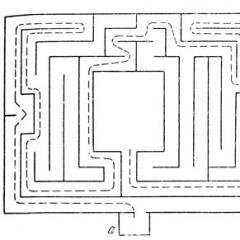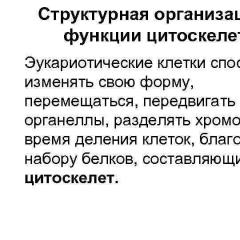Continue numerical test 11 24.3.2. Methodology “number series. Methodology “Complex Analogies”
Scales: level of development of logical thinking
Purpose of the test
Study of the logical aspect of mathematical thinking.
Test instructions
Children's version:“Carefully read each row of numbers and in two empty cells write two numbers that will continue this number series.”
Examples:
Example No. 1 2 4 6 8 10 12 14 16
Example No. 2 10 9 8 7 6 5 4 3
Example No. 3 3 3 4 4 5 5 6 6
Example No. 4 1 7 2 7 3 7 4 7
The added numbers are highlighted italics.
Test
№1 3 4 5 6 7 8
№2 5 10 15 20 25 30
№3 8 7 6 5 4 3
№4 9 9 7 7 5 5
№5 3 6 9 12 15 18
№6 8 2 6 2 4 2
№7 5 9 12 13 16 17
№8 27 27 23 23 19 19
№9 8 9 12 13 16 17
№10 1 2 4 8 16 32
№11 22 19 17 14 12 9
№12 4 5 7 10 14 19
№13 12 14 13 15 14 16
№14 24 23 21 20 18 17
№15 16 8 4 2 1 1/2
№16 18 14 17 13 16 12
№17 12 13 11 14 10 15
№18 2 5 10 17 26 37
№19 21 18 16 15 12 10
№20 3 6 8 16 18 36
Test instructions
Adult version: “You are presented with 7 number series. You must find the patterns in the construction of each row and enter the missing numbers instead of the dashes “-”. Time to complete the work is 5 minutes.”
Test material
№1 24 21 19 18 15 13 - - 7
№2 1 4 9 16 - - 49 64 81 100
№3 16 17 15 18 14 19 - -
№4 1 3 6 8 16 18 - - 76 78
№5 7 16 9 5 21 16 9 - 4
№6 2 4 8 10 20 22 - - 92 94
№7 24 22 19 15 - -
Processing and interpretation of test results
Key to the test
Children's version
№1. 9 10 №11. 7 4
№2. 35 40 №12. 25 32
№3. 2 1 №13. 15 17
№4. 3 3 №14. 15 14
№5. 21 24 №15. 1/4 1/8
№6. 2 2 №16. 15 11
№7. 29 33 №17. 9 16
№8. 15 15 №18. 50 65
№9. 20 21 №19. 9 6
№10. 64 128 №20. 38 76
Adult version
№1. 12 9 №5. 13
№2. 25 36 №6. 44 46
№3. 13 20 №7. 10 4
№4. 36 38
Interpretation of test results
If a subject finds it difficult to solve such problems, this may mean that he does not analyze digital material well, does not see hidden patterns in it, and therefore cannot use them, therefore his logical thinking in mathematics is poorly developed.
Sources
Methodology “Number series” / Almanac of psychological tests. M., 1995, pp. 139-140.Diagnostics of Thinking
Lippman test “Logical patterns”.
Diagnostic goal: Study of the logical aspect of thinking.
Testing procedure. The subjects are presented with written series of numbers. They need to analyze each row and establish the pattern of its construction. The subject must identify two numbers that would continue the series. The time taken to solve the task is recorded.
Number series:
1) 2, 3, 4, 5, 6, 7
2) 6, 9, 12, 15, 18, 21
3) 1, 2, 4, 8, 16, 32
4) 4, 5, 8, 9, 12, 13
5) 19, 16, 14, 11, 9, 6
6) 29, 28, 26, 23, 19, 14
7) 16, 8, 4, 2, 1, 0,5
8) 1, 4, 9, 16, 25, 36,
9) 21, 18, 16, 15, 12, 10
10) 3, 6, 8, 16, 18, 36
Processing and interpretation of results.
The key to the “Logical Patterns” technique.
| Presented ranks | Right answers |
| 2, 3, 4, 5, 6, 7 | 8;9 |
| 6, 9, 12, 15, 18, 21 | 24;27 |
| 1, 2, 4, 8, 16, 32 | 64;128 |
| 4, 5, 8, 9, 12, 13 | 16;17 |
| 19, 16, 14, 11, 9, 6 | 4;1 |
| 29, 28, 26, 23, 19, 14 | 8;1 |
| 16, 8, 4, 2, 1, 0,5 | 0,25;0,125 |
| 1, 4, 9, 16, 25, 36, | 49;64 |
| 21, 18, 16, 15, 12, 10 | 9;6 |
| 3, 6, 8, 16, 18, 36 | 38;76 |
The results are assessed using a table.
Evaluation of results using Lippmann's method.
| Job execution time (min, s) | Number of mistakes | Points | Level of development of logical thinking |
| 2 minutes. or less | Very high level of logical thinking | ||
| 2 minutes. 10 s - 4 min. 30 s | Good level, higher than most people | ||
| 4 min 35 s - 9 min 50 s | 3+ | Good norm for most people | |
| 4 min 35 s - 9 min 50 s | Average rate | ||
| 4 min 35 s - 9 min 50 s | 2-3 | 3- | Low rate |
| 10 min. - 15 min. | 4-5 | Below average level of logical thinking development | |
| 10 min. - 15 min. | 0- 3 | 2+ | Low speed of thinking, slow-witted |
| More than 16 min. | More than 5 | Defect in logical thinking in a person who has completed primary school education or high fatigue |
Number series:
1) 2, 3, 4, 5, 6, 7
2) 6, 9, 12, 15, 18, 21
3) 1, 2, 4, 8, 16, 32
4) 4, 5, 8, 9, 12, 13
5) 19, 16, 14, 11, 9, 6
6) 29, 28, 26, 23, 19, 14
7) 16, 8, 4, 2, 1, 0,5
8) 1, 4, 9, 16, 25, 36,
9) 21, 18, 16, 15, 12, 10
10) 3, 6, 8, 16, 18, 36
Methodology "Complex analogies".
Diagnostic goal: The technique is used to determine how accessible the subject is to understanding complex logical relationships and identifying abstract connections.
Testing procedure. In the “Sample” there are 6 pairs of words, each of which has certain relationships, for example, “Sheep - flock” - part and whole, “Raspberry - berry” - definition, “Sea - ocean” - differ in quantitative terms, etc. d. In the “Material” part there are pairs of words, the principle of connection of which subjects must compare with one of the samples, for example, “Chapter is a novel” similar to “Sheep – a flock” (indicate the number of a similar sample: “Chapter is a novel” - 1).
Instructions: On the form in front of you are 20 pairs consisting of words that are in a logical connection with each other. Opposite each pair are 6 letters that indicate 6 types of logical connections. Examples of all 6 types and their corresponding letters are given in the “Sample” table. You must first determine the relationship between the words in the pair. Then select the most suitable pair of words from the “Sample” table by analogy (association). And after that, in the letter row, circle the letter that corresponds to the analogue found in the “Sample” table. The task completion time is 3 minutes.”
Processing and analysis of results. Check the correctness of the answers and the level of development of logical thinking using the “key”.
Sample:
Sheep - flock
Raspberry - berry
Sea ocean
Light-dark
Poisoning - death
Enemy-enemy
Stimulus material:
Analysis of results done using a table.
Level of development of conceptual thinking using the Complex Analogies method"
| Number of mistakes | Balls | Level of development of conceptual thinking |
| A very high level of logical-conceptual thinking, the logic of concepts is unmistakably “caught” in one’s own and others’ reasoning | ||
| A good level, higher than most people, is able to logically clearly express his thoughts in terms of | ||
| 3+ | A good norm for most people, but there are sharp inaccuracies in the use of concepts | |
| 3-4 | Average norm, sometimes mistakes are made, inaccuracies in the use of concepts | |
| 5-6 | 3- | Low standard, often “confused”, inaccurately expresses one’s thoughts and misunderstands the complex reasoning of others |
| 7 or more | Below the average level of conceptual thinking, or Russian is not a “native” language, a person does not distinguish between concepts. |
Key to the “Complex Analogies” technique
| Presented pair of words | Correct answer |
| Fright - flight | |
| Physics - science | |
| Right - right | |
| Garden bed | |
| Praise - scolding | |
| pair - two | |
| Words - phrase | |
| Vigor - lethargy | |
| Freedom - independence | |
| Revenge - arson | |
| Ten is a number | |
| Idleness - idleness | |
| Chapter - novel | |
| Rest - movement | |
| Thrift - stinginess | |
| Cool - frost | |
| Deception - mistrust | |
| Singing is an art | |
| Drop - rain | |
| Joy - sadness |
Sample:
Sheep - flock
Raspberry - berry
Sea ocean
Light-dark
Poisoning - death
Enemy-enemy
| Presented pair of words | Correct answer |
| Fright - flight | |
| Physics - science | |
| Right - right | |
| Garden bed | |
| Praise - scolding | |
| pair - two | |
| Words - phrase | |
| Vigor - lethargy | |
| Freedom - independence | |
| Revenge - arson | |
| Ten is a number | |
| Idleness - idleness | |
| Chapter - novel | |
| Rest - movement | |
| Thrift - stinginess | |
| Cool - frost | |
| Deception - mistrust | |
| Singing is an art | |
| Drop - rain | |
| Joy - sadness |
Methodology “Number Series”, or Assessment of Mathematical Thinking.
Diagnostic goal: Study of the logical aspect of mathematical thinking.
Instructions:“You are presented with 7 number series. You must find the patterns in the construction of each series and enter the missing numbers. Completion time: 5 minutes.”
Stimulus material. A piece of paper with examples printed on it.
Number series
1) 24 21 19 18 15 13 _ _ 7
2) 1 4 9 16 _ _ 49 64 81 100
3) 16 17 15 18 14 19 _ _
4) 1 3 6 8 16 18 _ _ 76 78
5) 7 16 9; 5 21 16; 9 _ 4
6) 2 4 8 10 20 22 _ _ 92 94
7) 24 22 19 15 _ _
Processing the results produced by the key:
1) 12 9 5) 13
2) 25 36 6) 44 46
3) 13 20 7) 10 4
4) 36 38
The score is based on the number of correctly written numbers. The norm for an adult is 3 and above.
Interpretation of results.
If the subject finds it difficult to answer when solving such problems, this may mean that he does not see hidden patterns in him, therefore he cannot use them, therefore, his logical thinking in mathematics is poorly developed.
Number series
1) 24 21 19 18 15 13 _ _ 7
2) 1 4 9 16 _ _ 49 64 81 100
3) 16 17 15 18 14 19 _ _
4) 1 3 6 8 16 18 _ _ 76 78
5) 7 16 9; 5 21 16; 9 _ 4
6) 2 4 8 10 20 22 _ _ 92 94
7) 24 22 19 15 _ _
“Generalization” technique.
Diagnostic goal: Study of the ability to generalize and abstract, the ability to highlight essential features.
Testing procedure. Test subjects need to read the words of each row, identify the “extra” word and say what unites the remaining words.
The essence of the technique is to establish the patterns underlying the construction of a number series and find the number that should continue this series.
Let's look at the methodology for completing the task using specific examples:
|
28 26 24 22 ……. | ||||||
|
3 6 12 24 …… |
Number series are given on the left. For example, the number series is 1,2,3,4,5. The regularity of its construction is that each subsequent number is greater than the previous one by one, i.e. – the number that can continue this series is 6.
Look at the right side of the task where the answers are given. The correct option (example No. 1) is given under the index “3”.
Second example: the numbers 28,26,24,22 are given. Each subsequent number is two less than the previous one, i.e. the number that can continue this series is 20. The correct answer is in column “4”.
Third example: given numbers 3,6,12,24. Each subsequent one is twice as large as the previous one. The next number should be 48. But it is not in the answer options. This means that the correct answer is option “1” – there is no correct answer.
The “Number Series” technique is based on the principle of increasing difficulty. The construction of number series can be based on the arithmetic operations of addition, subtraction, multiplication, division, exponentiation, and root extraction. There may be combinations of two arithmetic operations (for example, addition and multiplication) or two parallel number series in one task.
To implement the “Number Series” technique, alloted 8 minutes.
STIMULUS FORM FOR METHOD 2 “NUMBER SERIES”
|
7 10 13 16 19 22 | ||||||
|
14 15 17 18 20 21 | ||||||
|
17 13 20 16 23 19 | ||||||
|
64 49 36 25 16 9 | ||||||
|
174 171 57 54 18 15 | ||||||
|
7 3 21 8 3 24 9 | ||||||
|
1,5 3 5,5 9 13,5 | ||||||
This resource is from the “Gymnastics for the Mind” series. Continue the number line. Part 2, created for students in grades 3-4. Work is carried out using control buttons. This resource can be used for frontal, group and individual work. The work uses the “Animated Sorbont” technological technique.
Target:formation of general intellectual skills.
Tasks:promote the development of attention and memory; develop self-control skills when working on a task on a personal computer; develop interest in challenging tasks.
Download:
Slide captions:
Slide 1
Series “Gymnastics for the mind” Continue the number series Part 2 Author of the presentation: Lidiya Petrovna Fokina, primary school teacher of the Municipal Municipal Educational Institution “Secondary School Art. Evsino" Iskitimsky district, Novosibirsk region 2016
Slide 2
Guys! Think about what pattern was used in constructing these number series and continue them. To check, click on the question card. Good luck!
Slide 3
? 2 ? 1 8 7 6 5 4 3
Slide 4
? 3 ? 3 9 9 7 7 5 5
Slide 5
? 2 ? 2 8 2 6 2 4 2
Slide 6
? 29 ? 33 5 9 13 17 21 25
Slide 7
? 7 ? 4 22 19 17 14 12 9
Slide 8
? 25 ? 32 4 5 7 10 14 19
Slide 9
Information sources Yazykanova E. V. Developmental tasks: tests, games, exercises: 4th grade. M.: Publishing House "Examen", 2015 (Series "Educational and Methodological Set") Frame Arrow Little Mermaid Algae Marine decor
On the topic: methodological developments, presentations and notes
Series “Gymnastics for the mind.” Find the extra word. Part 1
This resource is from the “Gymnastics for the Mind” series. Find the extra word. Part 1, created for students in grades 1-4. Work is carried out using control buttons. This resource can be used for front, group...
Series “Gymnastics for the mind.” Find the extra word. Part 2
This resource is from the “Gymnastics for the Mind” series. Find the extra word. Part 2, created for students in grades 1-4. Work is carried out using control buttons. This resource can be used for front, group...
Series “Gymnastics for the mind.” Find the common name. Part 2
This resource is from the “Gymnastics for the Mind” series. Find the common name. Part 2, created for students in grades 1-4. Work is carried out using control buttons. This resource can be used for front,...
Series “Gymnastics for the mind.” Continue the number line. Part 1
This resource is from the “Gymnastics for the Mind” series. Continue the number line. Part 1, created for students in grades 3-4. Work is carried out using control buttons. This resource can be used for front,...



